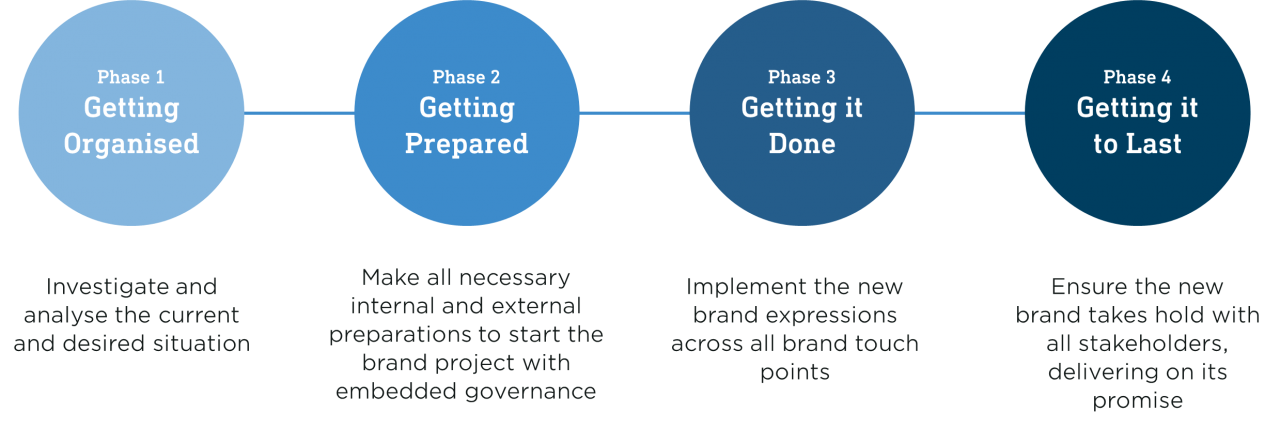
Last year, I shared my insights on important branding topics within the ‘Brands in the Boardroom’ series. This year, I started a new series on a topic about which I am very passionate: rebranding. In the first article, I shared the eight most common reasons for a rebrand, along with some examples of the largest rebrands of recent times. Now, I will talk about four important aspects of the business side of rebranding.
1. Making the case for a rebrand
Make no mistake, organizations don’t consider rebranding just for fun. It can be a substantial undertaking and requires careful planning, resources, good strategy and creative, and a business case – your CFO will also need to understand the rationale and the associated risks.
By applying some Simon Sinek terminology to rebranding, we can categorize the following elements in a potential rebrand:
The Why – the rationale for rebranding, either one or more of the eight reasons for a rebrand I described in part I – why are we rebranding?
The What – what will change due to the rebranding: purpose, name, brand expression, style, tone of voice, logo, or any combination of these? What is it that the brand stands for and how will it look, sound, think, and perform in an ideal world going forward?
The How – how will the organization deal with the dynamics of the change? How will we organize this process and how will we bring the rebrand/brand refresh to life across all touchpoints and channels, both in our internal and external communications, and through our brand expression, to maximize the impact and minimize costs?
Working with many organizations around the world that are evaluating whether to rebrand, I am fascinated that the brand leaders at many of our clients, the very people who are building the case for brand change, focus so heavily on the ‘why’ and the ‘what’ that they often risk undermining the initiative by neglecting the ‘how’.
“In the boardroom, finance and business are the languages that are understood.”
This perhaps comes as no great surprise, given that so many brand leaders have a background in marketing and communications, rather than in business administration. In the boardroom, however, finance and business are the languages that are understood, so it’s paramount that brand leaders also speak to the ‘how’ if they truly wish to be heard. Without a clear case for this, no board – and more specifically, no CFO – is going to approve a rebrand process. The board will undoubtedly want answers to the following questions:
- How will we set up a program to get this first time right – as the brand is our most valuable intangible asset?
- What will be the interdependencies between this initiative and others that we already have going on?
- What are the roll-out options – do we have a choice? What are the pros and cons?
- Alongside providing budgets for the roll-out options, do we also have opportunities to realize savings and synergies?
- What will be the incremental budgets required, broken down into OPEX and CAPEX, and also into internal communication, external communication, and changing assets and touchpoints?
- What internal resources would be required to effect change and how much will that cost?
- If we rebrand companies that we have acquired (sometimes years ago), how will that affect the book value of the goodwill that we have in our balance sheet?
- Would our internal or external royalty charge for the transfer pricing of the brand be affected by this rebrand?
Whilst this is not a comprehensive list, one can see that there’s more complexity than just coming up with a compelling ‘why’ and ‘what’ for an initiative like this, which is why I refer to the ‘how’ as ‘the business side of rebranding’.
Over the years, I have gained some valuable insights into the financial impact of a brand change or rebrand, having consulted on different rebranding programs. Having collated the figures from hundreds of rebrands over the past 20 years into a comprehensive database, it is possible to provide an indicative calculation for the level of investment required for any given rebrand.
2. The agency ecosystem you need for rebranding
Once the need for a rebrand has been approved by the board, a myriad of things will have to happen in parallel, in a short period of time. Alongside the appointment of a creative and communications agency, the actual planning of the rebrand will need to kick into gear.
Time and time again, I see that finding the right agency setup is a real challenge for clients. I believe this is because clients use agencies sporadically and not always for the same tasks and expertise, therefore it can be difficult to stay up to date on the performance and capabilities of all agencies. A common tactic is to run pitches, which can present as many problems as it does solutions.
Whilst the pitch process is a tried-and-tested means of selecting an agency, in addition to the challenges for agencies, this archaic approach is often counter-productive for potential clients. The ‘win at all costs’ mentality that many agencies understandably bring to the table often leads to them presenting themselves in the way that the client’s brief implies they should, rather than a true and, more than likely, more useful representation of itself. This might involve a misrepresentation of capabilities or experience, and it would be naive to expect that the winning creative idea hasn’t come from freelance talent or that the team delivering the pitch is the team that will actually deliver the work itself – classic agency hustle. The time invested in looking for an agency looks all the more wasteful when the decision isn’t made for the right reasons.
“I’ve learned, over the years, that handpicking and introducing experienced specialists to clients is far more effective than running a pitch.”
Of course, there are many other pitch-related factors that can cause a strain on the agency relationship before you’ve even started working together: arduous terms and conditions, excessive investment (financial, time, and resource), not to mention setting an unhealthy precedent whereby the agency is at the client’s beck and call. Hardly the way to start a long-lasting and mutually beneficial partnership of peers. The message is clear: a different tack is required.
I’ve learned, over the years, that – based on a well-crafted brief – handpicking and introducing experienced specialists to clients works faster, is less frustrating for all, and above all, far more effective in creating value for organizations and their agency ecosystems in the long run.
A good overview of international rebrandings over the last decade, and their agencies and awards, can be found on rebrand.com, an independent international source for rebranding cases.
3. Rebrand execution: planning for implementation
It is all very well having invested in the development of a powerful new brand identity, but without the requisite preparation and planning for implementation, it will not fulfill its potential. So often I see that the evaluation of the implications for brand roll-out is an afterthought, when the creative process is already well underway. This is counter-intuitive, given the relatively high spending required for brand implementation when compared with the investment in the development of the brand identity itself. Indeed, our database on the spend of rebranding initiatives tells us that if you spend $1 on the creative process, on average, an organization will spend $20 on its implementation.
A successful rebranding requires starting a rigorous planning and preparation process for roll-out before commencing the creative process. The preparation and planning of the roll-out process can take place without knowing what the actual creative expression is going to be. As long as an organization has a good understanding of the potential routes, an experienced partner can translate these into a comprehensive evaluation of the extent of change required, as well as associated financial and organizational implications of the roll-out options. Consequently, the planning-and-investment case development can take place parallel to the creative development process. By running the creative process (the magic) and the planning and preparation (the logic) in parallel, organizations are able to present the full picture of the rebrand at the same time to their board, better facilitating the decision-making process. Circling back to Simon Sinek’s terminology, it is how you bring the ‘why’, the ‘what,’ and the ‘how’ together in the business case for change.

4. Deriving media value from a rebrand
By its very essence, a rebrand is intended to signal change – so, any opportunity to communicate that to audiences at no additional cost is tremendously valuable. As such, when it comes to a rebranding process, it is important to properly understand what the challenges and opportunities are, especially where this relates to paid, owned, and earned media.
Regardless of whether the rebrand is revolutionary (e.g., a name change or a bold new identity) or evolutionary (e.g., a new tone-of-voice or refreshed visual identity), all of the brand’s stakeholders – be those customers, members, employees, investors, wider society, financiers, or suppliers – will recognize the change and start wondering what’s happening, and more importantly, why.
“With a rebrand, an organization gets a ‘free’ opportunity to explain why all of this is happening.”
This is where the distinction between owned, earned, and paid media comes in. A rebrand can be supported by paid media, and it often is. However, the aforementioned subliminal curiosity amongst the brand’s internal and external stakeholders is often taken for granted – essentially, an organization gets a ‘free’ opportunity to explain why all of this is happening.
In communication terms (assuming a compelling story is being told) a rebrand can provide huge value in that it naturally generates attention without the need for an additional media spend. So, when making a business case for a rebrand, one should offset the potential earned media value (flowing on from effective communication of the change through owned channels and touchpoints), versus what one would have to spend to get a similar message out and understood by the audience.
It is this very consideration that I have seen resonate with many board members of our clients when making the final call to move ahead with a rebranding program. As I previously mentioned, ultimately, a rebrand is intended to signal change and if that can be broadly communicated without having to spend millions on communications campaigns, this makes a compelling business case to any board.
The importance of a clear strategy for the ‘how’ of rebranding
Far too often, the business side of rebranding is overlooked in the early planning stages. Whilst there is no denying the importance of a clear strategy for the ‘why’ and the ‘what’, so many rebrand initiatives fall down when they reach the board-level, decision-making stage because they have failed to fully grasp the ‘how’.
Rebrands are notoriously risky endeavors but failing to take action when it is required can be catastrophic for an organization. Given the stakes at play, any board is going to want to fully understand the required investment – after all, if properly planned, this investment can yield great benefits.
Cover image source: Icons8 Team and Emilio Takas
